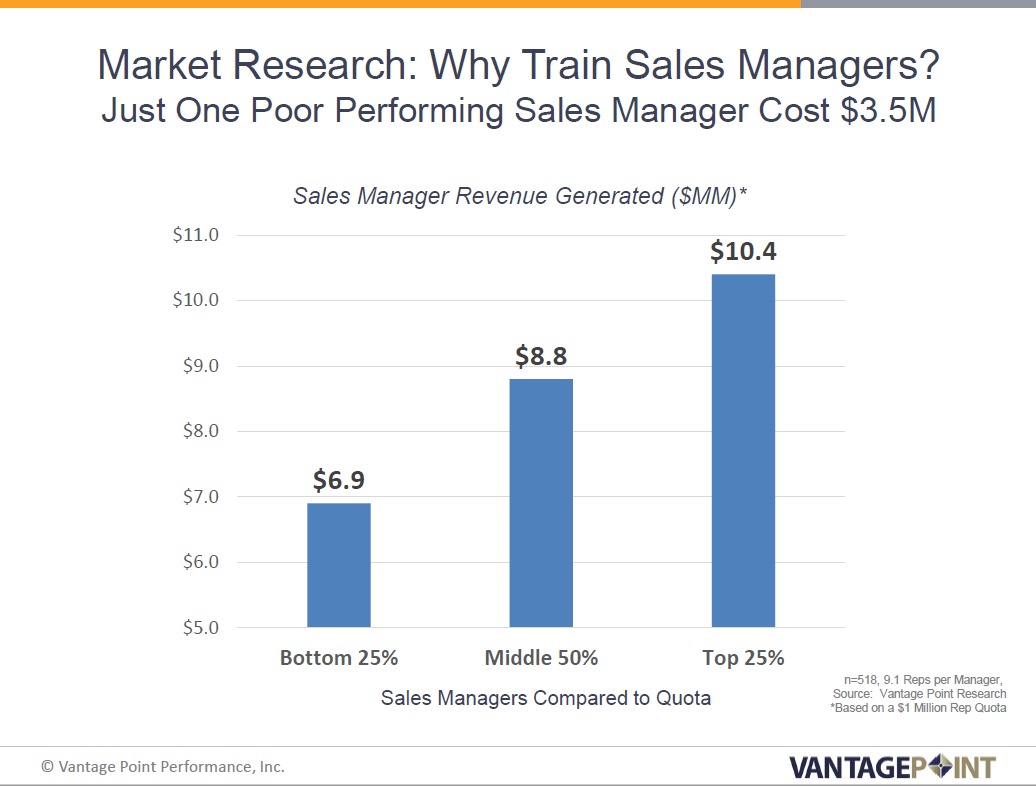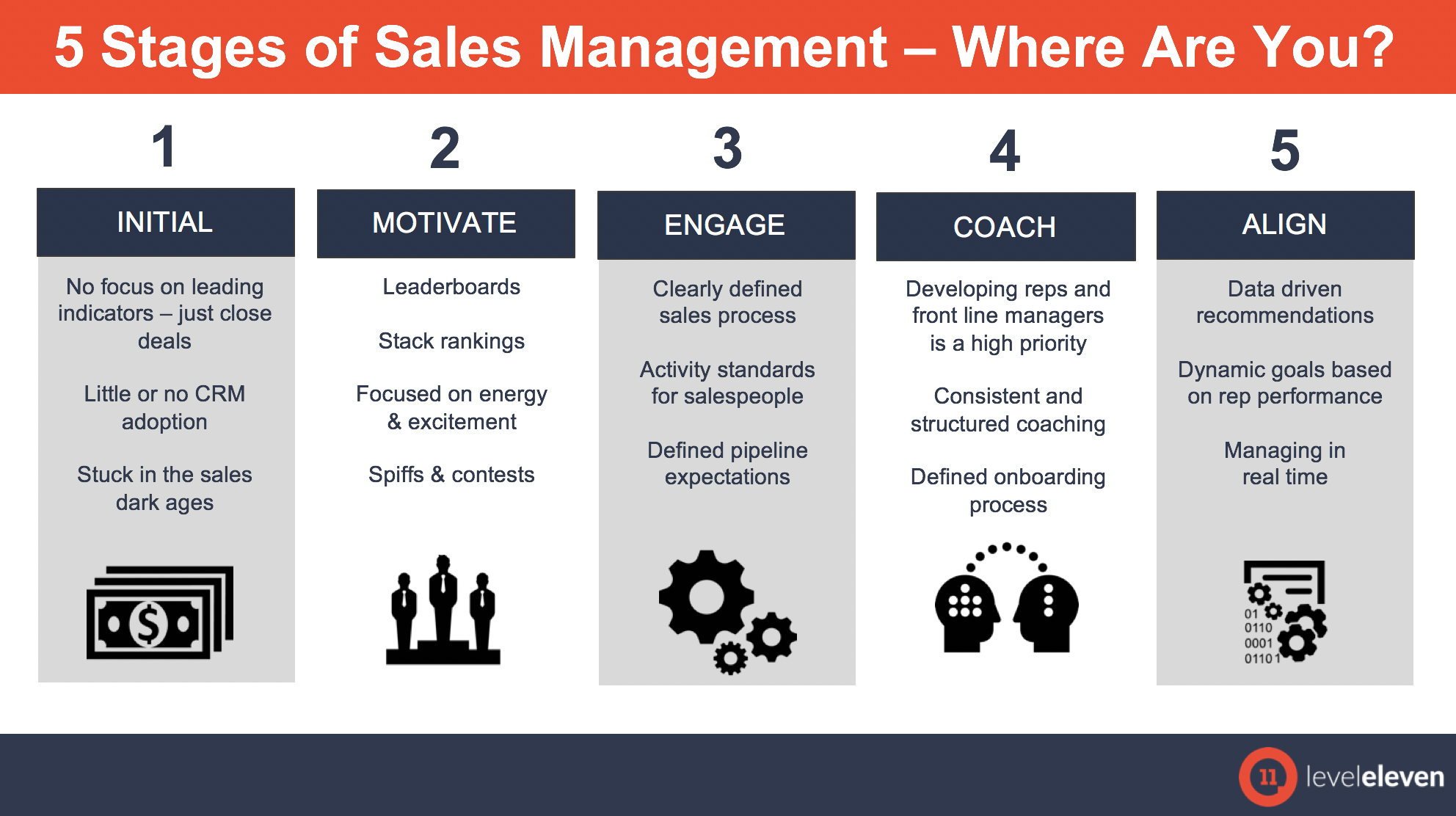Anytime someone moves into a new role, there is an adjustment period to figure out how to be effective. When that transition is from an individual contributor to manager, that adjustment can be even more jarring. We all know the typical story with sales managers – they were a top performing salesperson, had ambitions to move up in their career, and then a position opens up and they are managing a group of salespeople.
High performing salespeople are often successful for reasons they do not fully understand. While their “get it done” attitude helps a great deal, it’s more than that. Simply put, they naturally have the discipline to execute successful sales actions consistently. They are regularly prospecting, networking, building pipeline, qualifying that pipeline and maintaining momentum with current opportunities. They follow a defined process, but often do not realize that they are doing it – it just comes naturally.
Excellent sales management is key to the success of every sales team. Sales managers are the front-line leaders that make or break an organization because they have the most influence on the performance of each salesperson. Research from Vantage Point Performance shows that top-performing managers generate $3.5 million more sales per year compared to low-performing managers. Let me say that again, $3.5M more sales per manager! No matter how large or small your sales staff that number adds up.[1]
Sales managers can go from good to great as their career progresses with the help of professional advice and a proven plan for growth. Luckily, The 5 Stages of Sales Management have both!
Stage 1: Initial
Many sales managers get stuck in this stage, especially when they are new to management, or they work for firms that are “stuck in the dark ages” when it comes to technology and developing culture. This group only cares about what they are closing and how much others have sold. Nothing else matters, as they assume the sales team knows how to get there – just like they did.
With these sales managers, one-on-ones rarely happen and all they only want to know is what’s closing this month and how they can swoop in on a deal to help win it faster. While we can all appreciate the need for a resolute focus on results, the Stage 1 sales manager is blind to the process that leads to those results.
Eventually, sales manager caught in this stage realize that efficiently moving through the sales process is not as intuitive for everyone on their sales team and moves to Stage 2.[2]
Stage 2: Motivate
In this stage, the sales manager identifies critical steps of the sales process that are being missed. For example, she may notice that some reps get easily distracted in customer service issues or proposal writing which prevents them from prospecting consistently or remaining focused on progressing existing opportunities through the buying process and towards closure.
The Stage 2 sales manager understands the process side of sales. They see that it’s their job to utilize their available resources to help maximize sales output. They are not an individual seller anymore, and they are now responsible for a larger payroll that requires a new level of productivity to meet the increased demands. In an attempt to encourage the right behaviors, Stage 2 managers will use incentive-based contests and team leaderboards to try and motivate the team. This approach works, especially if it is new to the team. It helps get people focused and keeps things exciting for the team. Unfortunately, this method typically only works at first, as it is simply not sustainable. Contests get expensive, and without variety, they eventually become stale and ineffective.[2]
Stage 3: Engage
In Stage 3, the manager defines a more clear sales process with clear pipeline standards and sales KPIs so their sellers can be engaged every single day. These standards and KPIs are initially created based on the intuition of the sales manager. Then, once the team is acclimated to the new process and the new numbers start to roll in the plan evolves through observation and analysis. Managers look to their top-performers to identify successful practices they used and create best practices based on them. Conversely, team members who are underperforming can share their shortcomings to help educate the team and avoid future pitfalls. Any good sales manager keeps a close eye on closing, but also remembers that inputs drive outputs.
In this phase, each salesperson has clear expectations on things. For instance, how many new business meetings they need to have every month, how much pipeline they need to build, a common approach to qualifying (and disqualifying) opportunities, how much qualified pipeline should be open at any given time (a.k.a. pipeline coverage) and a solid forecast approach. Here the full team knows what is expected of them, there is a common language the team is using, and by leveraging data the manager and salespeople can add some objectivity to the sales process.
Step 3 is a big leap forward from the “just close deals” approach, with metrics and reports being leveraged and best practices being created, refined and replicated. Unfortunately, many salespeople still tend to lose focus and stray away from even the most proven practices if the sales manager is not reinforcing their importance and holding people accountable.[2]
Stage 4: Coach
In Stage 4, the sales manager starts running what I like to call a “Closed Loop Management Process.” The idea being that in Stage 3 the new sales manager has defined key metrics to manage around, and ensures that these metrics should be regularly reviewed with each salesperson – their weekly team meeting and in one-on-ones. As they begin to fine-tune their craft, sales managers begin to realize what being a “coach” really means in Stage 4.
Now, with operating measures in place, the manager can keep an eye on them regularly, and salespeople clearly understand their importance and that they will be held accountable. It is not all about the numbers, but these metrics are effective guides to use during coaching conversations. For example, if a rep isn’t hitting his monthly new pipeline goal, the manager knows this is where to focus that person’s sales coaching.
As manager and sellers become more comfortable and familiar with where they need to focus their time and attention, they also start to get curious about data practices and optimizations. They want their data to be more personalized, in real-time and even more expansive.[2]
Stage 5: Align
In Stage 5, sales teams reach a new level of alignment from the top-down. From executives to the latest new hire, there’s a common language around the critical steps and measures of the sales process, metrics and goals are personalized for each salesperson, and everyone has a real-time view of where he or she stands. At any given moment, any sales manager can see if their team is ahead or behind on key metrics, which empowers her to make corrections and get things back on track.
Salespeople are not waiting for the next team meeting or one-on-one to find out how they are doing. They always know where they stand. This stage also allows for rapid onboarding as new hires come in with a set of clearly defined metrics to immediately execute (e.g., meetings and pipeline needed). Even better, goals can be set to scale up as reps gain experience. Rather than waiting 3-to-6 months to close a deal and feel valuable, reps can start executing immediately and know they are on track to hit their quota![2]
[2]https://labs.openviewpartners.com/sales-management/#.Wnw685PwaXQ




